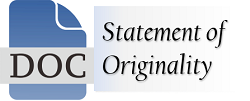Author Guidelines
The following guidelines for prospective authors apply:
- Manuscripts are the results of research, theoretical studies, literature studies, or critical conceptual ideas around current issues that are objective, systematic, analytical, and descriptive.
- Manuscripts must be original works and have never been published in other journals or other media.
- Manuscripts sent are not in the process of editing, reviewing, or publishing in other journals.
- Manuscripts can be written in Bahasa or English.
- Article writing using standard language that is approved, straightforward, simple, easy to understand, and does not contain multiple meanings.
- Systematics of writing includes: (a) Title of the manuscript, (b) Identity of the author (Author's name without an academic title, Name of Agency or Institution, and email address of the author), (c) Abstract accompanied by keywords (English and Bahasa), Introduction, Research Methods, Discussion (sub-chapters follow the studies discussed in the article), Conclusions, Suggestions and Recommendations, Bibliography.
- Writing format as follows:
- The manuscript is sent in the form of a document file with the entire script length, including footnotes and bibliography, ranging from 4,000 to 6,500 words (18-25 pages).
- Unless otherwise indicated earlier, abbreviations should be avoided. Titles of article should be written out in full.
- Abstract of 150-200 words are written in one paragraph and 1 (one) space in English and Bahasa.
- Keywords in English and Bahasa are written above the abstract amount of 3-5 words.
- The manuscript is typed on A4 size paper with Arial font size of 10 pt font size and 1 spaces.
- Writing citations must include the source in the form of a bodynote (APA style). Writing quotes using a reference management application such as Mendeley, Zotero, etc. is preferred.
- Reference should be from the most recent edition. Writing bibliography arranged alphabetically by category; Books, Journals, Legislation, the Internet.
- The author must guarantee the validity of the writing and does not violate the scientific code of ethics and does not violate copyrights.
- The contents of the writing are not the responsibility of the editor. The editor has the right to edit the editorial without changing the substance.
- Authors should be willing to respond to questions from readers of their articles.
- All article manuscripts will be peer-reviewed by qualified academics in the field; this is a process that may take weeks or months.
TITLE
The title of the manuscripts should be brief and clear, no more that 14 words for Bahasa Indonesia or 10 words for English all caps, Arial, capital 18pt, bold, centered. Author(s) name should exclude an academic degree or an indication of position and rank, Arial, 10pt, single space. Author(s) affiliation and email are written with Arial, regular, 10 pt, single space.
ABSTRACT
Abstracts are written with a maximum of 150-200 words in English and Bahasa Indonesia. Abstracts must be clear and descriptive which provide a brief description of the problem under study. Abstract includes the reasons for choosing a topic or the importance of the topic of the research, research methods and summary of results. Abstracts must end with comments about the importance of the results or concise conclusions. Font type used Arial, italic, 10 pt, single space.
KEYWORDS
Keywords are the labels of your manuscript and critical to correct indexing and searching. Therefore the keywords should represent the concept that highlight your article. The keywords should be 3 to 5 keywords. Use only those abbreviations that are firmly established in the field. e.g. DNA. Each words/phrase in keyword. 10 pt, Arial, italic
INTRODUCTION
The introduction outlines the background of the problem being resolved, the issues related to the problem being solved, the research reviews that have been done before by other researchers who are relevant to the research conducted. It is best to avoid organizing writing into "sub-title children" in this section.
The template for this article format was created in MS Word, and then saved in rtf format. This template allows article writers to prepare articles according to rules relatively quickly and accurately. 10pt Arial, regular, space 1, spacing before 0 pt, after 0 pt.
METHOD
Basically this section explains how the research was conducted, which includes (1) the problem to be examined; (2) research objectives); (3) data collection techniques; (4) and data analysis techniques. Pt 10pt Arial, regular, space 1, spacing before 0 pt, after 0 pt.
RESULTS AND DISCUSSION
The discussion in the article aims to: (1) answer the problem formulation and research questions; (2) shows how the findings were obtained; (3) interpret findings; (4) linking research findings to established knowledge structures; and (5) bringing up new theories or modification of existing theories.
In answering the formulation of the problem and research questions, the results of the study must be concluded explicitly. Interpretation of findings is carried out using logic and existing theories. Findings in the form of reality in the field are integrated / linked with the results of previous studies or with existing theories. For this purpose there must be a reference. In bringing up new theories, old theories can be confirmed or rejected, some may need to modify theories from old theories. 10pt Arial, regular.
CONCLUSION
The conclusions of the manuscripts contain constructive conclusion and suggestions for the development of the study. Conclusions present a summary of the description of the results and discussion, referring to the research objectives. Based on these two points, new ideas are developed which are the essence of research findings. 10pt, Arial, regular.
REFERENCES
This section lists books, articles or other references that the article made, which is also written in the footnotes list of articles. The type of reference recommended in the JKI refers to the APA Style. For consistency of references, please use the Zotero Reference Manager Applications or Mendeley. 10pt, Arial, regular.








_-_Copy1.jpg)


